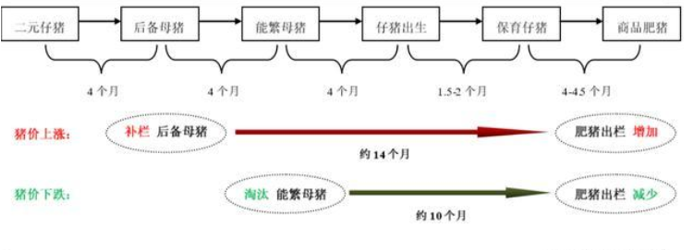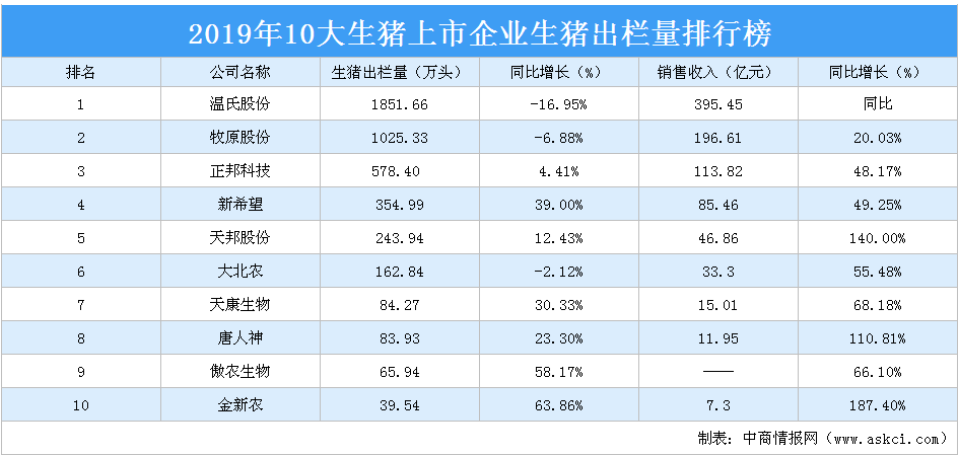How do pig companies respond to the decline in pork prices?
Editor’s note: href=”https://mp.weixin.qq.com/s/9L8zkGxL1Jjy2GUdH0Fm9w”> “market watch” public channel number from the micro herein , of: capitalization Observed.
Slow cattle market, food and beverage and other consumer industries have become important main lines. Among them, the stock price performance of the pork industry is even more stunning. The pork index has risen by more than 200% in the past two years, and some leading companies have risen by nearly 10 times.
The so-called purchase of pig stocks in the Year of the Pig is indeed very fragrant.
Performance Dilemma Reversal
is the root cause of the surge in pork stocks
Behind the surge in stock prices is the impulsive growth of pork company performance after a long period of industry downturn.
Before 2019, pork prices experienced a 21-month decline, and the performance of listed pig companies was dismal. Take Muyuan, whose pork income accounts for more than 95% of its main business, as an example. In 2018, its revenue increased by 33%, but its net profit fell by 78%. The decline in meat prices had a major impact on the company’s earnings.
Afterwards, with the impact of production capacity clearance, the impact of the African swine fever epidemic, and environmental restrictions on production, the supply of live pigs across the country fell rapidly, and prices gradually recovered. According to data from the National Bureau of Statistics, in 2019, my country’s live pig population was 31.04 million, a decrease of 27.5% over the previous year, and the total number of live pigs was 544.19 million, a decrease of 21.6% over the previous year.
The overall lack of supply in the market has caused pork prices to hit a record high, the profitability of pig farms has rebounded rapidly, and the performance of listed pig companies with relatively stable production capacity has experienced explosive growth.
Take Muyuan as an example. In 2019, its operating income increased by 51%, but its profit increased by 1075%; in the first three quarters of this year, its operating income increased by 233%, and its profit increased by 1413%. The performance clearly reflects Periodic characteristics of nonlinear growth.
YesSupported by performance, after the stock price of listed pig companies rose sharply, the valuation remained low, which seemed to have a high margin of safety. However, the cyclical nature of the pork industry makes people feel a little chill.
The investment logic of the pork industry
In the short and medium term, be alert to cycle reversals
The pork industry is a typical cyclical industry. Due to the special growth cycle of live pigs, it takes a long time to realize the expansion and contraction of production capacity, and there will be cyclical fluctuations in pork prices and production, which will have a cyclical impact on performance.
▲Data source: Northeast Securities
Similar to cyclical companies, due to the non-linear trend of performance, the short-term logic of investing in pork companies is not the level of valuation, but the turning point of cycle and performance. At the low point of the cycle, high valuation is not a major risk; at the high point of the cycle, low valuation may also become an investment trap.
Since 2006, pork prices have gone through 4 complete cycles, each with an average of about 45 months, of which the upward cycle averages 20 months and the downward cycle averages 25 months.
For the judgment of pig cycle, important reference data comes from the stock and the number of sows capable of breeding. When the two are at a low level, it is often the bottom of the down cycle that may usher in a reversal upward; when the two are at a high level, it is often the top of the upward cycle that may usher in a reverse downward.
As far as the current cycle is concerned, the pig price has been rising for the longest time in history. Driven by interests, farmers have been enthusiastic since last year and production capacity has continued to expand.
Data from the Bureau of Statistics show that as of the end of September, the country’s live pig stock reached 370 million heads, recovering to 84% at the end of 2017; the stock of breeding sows reached 38.22 million heads, recovering to 86% at the end of 2017. The expansion of production capacity has led to a downward trend in prices. The latest data released by the Ministry of Agriculture show that since the end of October, the average pork price in the national agricultural product wholesale market has fallen for 10 consecutive weeks, falling below 40 yuan.
With the further increase in production capacity, the pork industry will re-enter the downward cycle of overcapacity and price declines. In the future, the performance of pork companies may be greatly impacted in the short to medium term.
medium lengthFocus on opportunities for industry concentration enhancement in the period
Even under short-term pressure, in the medium and long term, the performance of leading pork companies still has a high degree of certainty. The main logic comes from the increase in industry concentration.
Compared with overseas markets, the production capacity of pig farming in my country is seriously dispersed, and the market share of leading companies is still in a low range. Even according to the extreme conditions during the African swine fever period in 2019, the market share of the industry leader Wen’s shares is only 3.4%, and the CR10 of the pig industry is only about 9.4%.
In other countries, the pork industry is highly concentrated. Public data shows that the domestic market share of leading French companies is 24.83%, Spain is 16.85%, the United States is 14.66%, Brazil is 12.93%, Poland is 9.72%, the United Kingdom is 9.11%, Italy is 8.76%, Vietnam is 6.76%, Canada It was 6.01%, Russia was 4.64%, and Denmark was 3.7%.
With the improvement of environmental protection and food requirements, the pattern of large-scale, standardization and oligopoly in pig breeding is the general trend. With reference to international experience, the market share of my country’s high-quality enterprises has ample room for improvement. Taking into account the huge market size of my country’s live pig industry, even if CR10 is only increased to 20%, it will greatly improve the performance of leading companies.
Comparative analysis of the 4 leading companies in the pork industry
According to the statistical data of the slaughter volume in September, the top 4 pork industry is Muyuan, Wenshi, Zhengbang Technology and new hope. There are many differences in the income structure, business model and business strategy of each company, which will have different effects on their respective performance.
Income Structure
According to the 2020 Interim Report,The income from pig farming of the original shares accounted for more than 98%, Wen’s and Zhengbang science and technology pigs accounted for more than 70%, and New Hope, as a latecomer, accounted for only about 15% of similar income.
This income structure determines the performance of Muyuan shares and is relatively more affected by the pig cycle.
Aquaculture Mode
Except for Muyuan who is all self-supporting, Wen’s almost all have a “company + farmer” model, and both Zhengbang and New Hope have both models.
The company + farmer model has low investment and rapid expansion of production capacity, but it is difficult to control quality. Self-support is easy to control the quality, but the investment is large and the capacity expansion is slow. This is also the reason why Muyuan’s capital expenditure is huge and the debt ratio is higher than Wen’s.
Live pig breeding growth rate
In the first nine months of this year, New Hope achieved the fastest growth rate of 81%, followed by Muyuan’s 49%, Zhengbang’s growth rate was 31%, and Wen’s bucking the trend fell by 50%.
The change in growth rate has caused major changes in the industry structure. Before 2020, Wen’s slaughter scale has always been the industry’s largest, but the low growth rate made it surpassed by Muyuan this year. As of September, Muyuan had sold 11.88 million heads, far surpassing Wen’s 7.06 million heads. Zhengbang Technology sold 5.92 million heads in September, which has also approached Wen’s scale.
From the monthly data, Wen’s sales volume in September has even dropped to the fourth in the industry.
The sharp decline in Wen’s sales volume is related to its prudent business strategy. Capital expenditure and current debt ratio have not been high. On the other hand, it may have made active adjustments based on its cycle judgment.
The rapid rise of New Hope, apart from being optimistic about the industry’s prospects, naturally cannot leave the company’s overall scale and the advantages of the entire industry chain.
Profitability and cash flow
According to the 3rd quarter report of 2020, Muyuan shares gross profit margin is 64%, net profit margin is 59%, ROE63%, net profit cash content is 91%, several indicators are much higher than other competitors. On the one hand, this is due to the relatively high proportion of Muyuan’s pork income, and on the other hand, due to the cost advantage and high quality premium brought by Muyuan’s self-operated model, as well as very few accounts receivable.
Long-term development plan comparison and capital expenditure
According to the plans of major companies, production capacity will increase substantially in the next few years:
· Wen’s plans to produce 56 million heads in 2024;
· Muyuan plans to produce 47.75 million pigs in 2021 and 94.96 million pigs in 2022;
Zhengbang plans to produce 230 in the next 3 years0 million head;
· New Hope plans to ensure that 25 million live pigs will be sold in 2022. The long-term plan is to produce 45 million pigs.
From the three quarterly reports, Muyuan’s capital expenditure reached 31.6 billion at the maximum, followed by New Hope and Wen’s.
In general, among the top 4 pork industry, Muyuan’s future performance growth should be the most certain, mainly because of its long-term high-quality self-operated model of production capacity certainty and quality controllability, which makes Its output, price, profitability and cash flow can be guaranteed.

